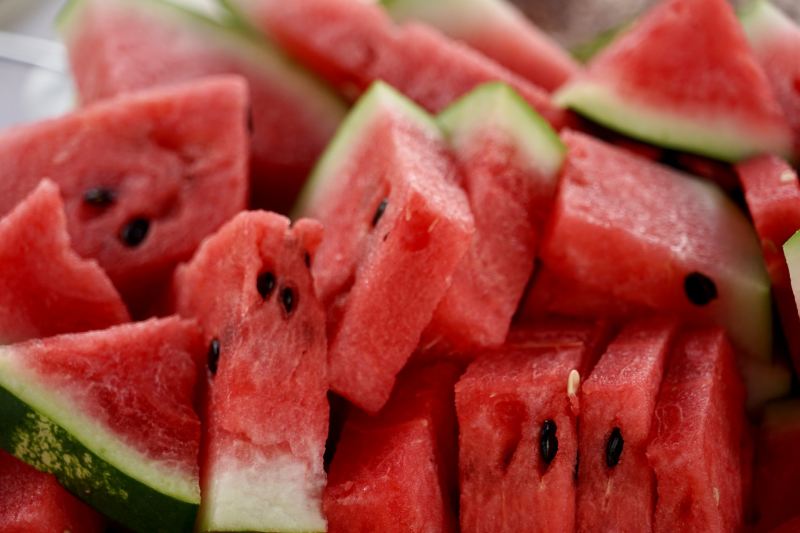
There’s something truly delightful about sinking your teeth into a slice of juicy, sweet watermelon on a hot summer day. But, as any produce enthusiast knows, not all watermelons are created equal. Picking the perfect watermelon from a store can be a bit of a mystery, but fear not! Want to know how to pick a watermelon? We’re here to guide you through the art of selecting the juiciest and most delicious watermelon every time you hit the grocery store.
How to pick a good watermelon
Look for a uniform shape
When it comes to watermelons, symmetry is your ally. Opt for watermelons with uniform shapes – these beauties are more likely to be evenly ripened. Irregular bumps or uneven contours might indicate inconsistent growth or potential internal issues.
Check the weight
Choosing a heavier watermelon is key for selecting a ripe and juicy fruit. The weight of a watermelon can provide valuable information about its internal water content and overall quality. Watermelons are made up of about 90% water, which is why heavier watermelon typically indicates a higher water content.
When you pick a heavier watermelon, you’ll likely get a juicier one. Watermelons with a higher water content can often have a longer shelf life. The water helps keep the fruit hydrated and fresher for a longer period, allowing you more time to enjoy it before it starts to deteriorate.
Avoid melons with bruises or cuts
Inspect the watermelon for any visible bruises, cuts, or damage. Flawed areas can affect not only the fruit’s appearance but also its taste. Bruises and cuts on a watermelon can damage the internal structure of the fruit. This damage can lead to the breakdown of cell walls, affecting the watermelon’s overall taste and flavor. These damaged spots can accelerate the spoiling process of the fruit, leading to a shorter shelf life. Picking a watermelon without bruises and cuts ensures you get the full, delicious flavor that a ripe and intact watermelon can offer. Choose a watermelon that’s free from blemishes for a consistently delicious experience.

How to choose a ripe watermelon
Check the field spot
The field spot, that patch where the watermelon rested on the ground while ripening, holds valuable clues about the fruit’s readiness. Seek out watermelons with a creamy yellow or orange field spot; this suggests it’s perfectly ripe. Steer clear of those with white or green spots, as they might not have reached their peak sweetness.
Tap the watermelon
Tapping your watermelon is another great way to figure out how good your watermelon is. A ripe one will produce a deep, hollow sound. Conversely, an underripe or overripe fruit will sound dull or flat. Remember, though, this method has some room for error, so don’t depend on it as your only method.
Choose a dull rind
While choosing the shiniest melon in the stack might be tempting, pause for a moment. A dull rind often indicates that the watermelon is ripe and ready to be enjoyed. As watermelons ripen, the skin loses its sheen and becomes less glossy, leading to a more muted, matte appearance. This change in texture is due to the fruit’s internal sugar content increasing. The sugars have had time to develop fully in a melon with a dull rind, resulting in a more satisfying taste experience. Shiny rinds can sometimes indicate underripeness, so choosing a watermelon with a dull rind helps ensure a delicious eating experience.
Choose one with a brown stem
The stem of the melon is where it was attached to the plant while growing. A brown stem on a watermelon indicates that the fruit was allowed to ripen on the vine until it was naturally detached. This is a positive sign because melons continue to develop their flavor, sweetness, and nutrients while on the plant. A brown stem suggests that the melon has reached a desirable level of ripeness and flavor. A green stem might imply early picking, so aim for watermelons with dried, brown stems – a clear indicator that the fruit ripened on the vine, soaking up all that sweet goodness.
Melons that ripen on the plant tend to have a better texture. They are often juicier, more tender, and have a smoother mouthfeel.
Picking the perfect watermelon is a skill that can only be mastered through practice and experimentation. By paying attention to these important traits, you can significantly increase your chances of selecting a sweet, juicy watermelon that will be the star of your summer gatherings.
The next time you’re standing in front of a display of watermelons, remember a few of these tips so you can confidently choose the very best one to savor under the sun.




